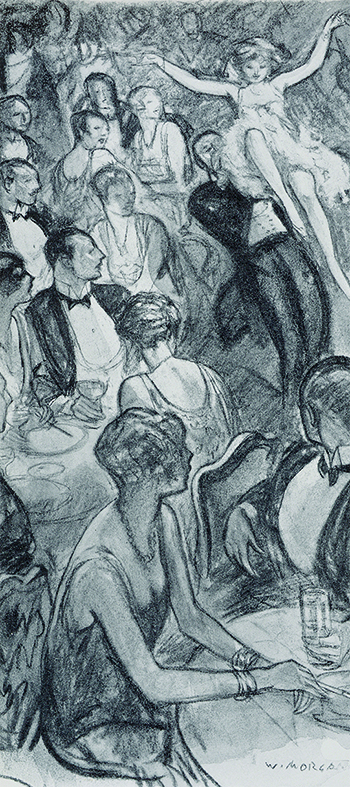1920 - 1929: A Breakthrough
 |
 |
 |
 |
 |
 |
 |

Capturing the "Roaring 20's" with its cabaret theme, Odorono (pronounced odor-oh-no!) is selling the dream of a hot evening, dancing the night away. Cabarets were places of both performance and participation, usually lubricated with liquor. They were widely popular in Paris and Berlin. In 1927 America, however, the alcoholic drinks depicted in this illustration indicated it was an underground establishment. Above: Odorono deodorant advertisement (detail), Harper's Bazaar July 1927.
For the first time in the history of Western Civilization, popular fashion of the 1920’s revealed women’s legs. Although the rebellious women we call “flappers” first appeared in the 1920s, the roots of the movement began in earlier decades.
By 1920, new technologies, such as automobiles, telephones, radios and moving pictures, expanded their reach and altered not only American culture but expectations in women’s lives. In the early 1900s the suffrage movement had begun to radicalize, with younger, more progressive women advocating not just for the vote but for full social equality.
In places such as Greenwich Village in the 1910s, feminists began wearing formless sacque dresses and rejecting corsets, thus using fashion to express both a political stance and new perspectives of themselves. Mainstream stores soon picked up on the trends, and after World War I, were marketing these new dress forms to the broad population. What began as an ideological display became commercialized and popularized for the masses and sparked the flapper style of the 1920s. These social changes, accompanying an emerging youth culture, bewildered many Americans, many of whom refused the new styles and lifestyle.
Women of the 1920s enjoyed new freedoms. After over 70 years of struggle, women had the right to vote. Furthermore, social customs were loosening. Women could now go out on dates, rather than supervised courting in the family home. Single women working outside the home were increasingly keeping their own money to spend on leisure. Paralleling these social and political changes, the looser, straight lines in dresses of the 1920s allowed women to toss aside the tight corsets of their mothers and grandmothers. These new fashionable lines, however, privileged youthful bodies. To achieve the fashionable looks, new undergarments were developed that flattened breasts and squeezed the hips.
Through technological advances, the ready-made clothing industry had reached maturity. For the previous ten years, women could purchase all their clothes ready-made from mail-order catalogs or local stores. As women’s clothing became looser fitting in the early twentieth century, readymade clothes with their predetermined standard sizes became more workable.
